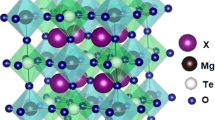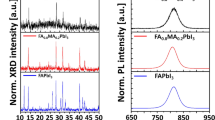Abstract
The interaction of heavily doped p- and n-type Si crystals with hydrofluoric acid in the dark with and without contact with metals having greatly differing work functions (Ag and Pd) is studied. The dependences of the dissolution rates of Si crystals in HF solutions that contain oxidizing agents with different redox potentials (FeCl3, V2O5 and CrO3) on the type and level of silicon doping are determined. Analysis of the experimental data suggests that valence-band holes in silicon are not directly involved in the anodic reactions of silicon oxidation and dissolution and their generation in crystals does not limit the rate of these processes. It is also shown that the character and rate of the chemical process leading to silicon dissolution in HF-containing electrolytes are determined by the interfacial potential attained at the semiconductor–electrolyte interface. The mechanism of electrochemical pore formation in silicon crystals is discussed in terms of selfconsistent cooperative reactions of nucleophilic substitution between chemisorbed fluorine anions and coordination- saturated silicon atoms in the crystal subsurface layer. A specific feature of these reactions for silicon crystals is that vacant nonbonding d 2 sp 3 orbitals of Si atoms, associated with sixfold degenerate states corresponding to the Δ valley of the conduction band, are involved in the formation of intermediate complexes. According to the suggested model, the pore-formation process spontaneously develops in local regions of the interface under the action of the interfacial potential in the adsorption layer and occurs as a result of the detachment of (SiF2) n polymer chains from the crystal. Just this process leads to the preferential propagation of pores along the <100> crystallographic directions. The thermodynamic aspects of pore nucleation and the effect of the potential drop across the interface, conduction type, and free-carrier concentration in the crystal on the pore size and structure are discussed. The concepts developed in the study can consistently account for experimental facts characterizing the etching of silicon crystals with various electrical parameters under various conditions providing the anodic polarization of crystals in HF-containing solutions.
Similar content being viewed by others
References
A. Volance, Phys. Rev. B 55, 9706 (1997).
M. Rausches and H. Spohn, Phys. Rev. E 64, 031604 (2001).
Xiaoge Gregory Zhang, Electrochemistry of Silicon and ItsOxide (KluwerAcademic, New York, Boston, Dordrecht, London, Moscow, 2004).
V. Lehman, R. Stengl, and A. Luigart, Mater. Sci. Eng. B 69–70, 11 (2001).
J. Carstensen, R. Prange, G. S. Popkirov, and H. Foll, Appl. Phys. A 67, 459 (1998).
M. I. J. Beale, N. G. Chew, M. J. Uren, A. G. Cullis, and J. D. Benjamin, Appl. Phys. Lett. 46, 1095 (1985).
O. Bisi, S. Ossicini, and L. Pavesi, Surf. Sci. Rep. 38, 1 (2000).
D. R. Turner, J. Electrochem. Soc. 107, 810 (1960)
D. R. Turner, J. Electrochem. Soc. 105, 402 (1958).
R. Memming and G. Schwandt, Surf. Sci. 4, 109 (1966).
P. Allongue, V. Kieling, and H. Gerischer, Electrochim. Acta 40, 1353 (1995).
K. W. Kolasinski, Phys. Chem. Chem. Phys. 5, 1270 (2003).
K. W. Kolasinski, Surf. Sci. 603, 1904 (2009).
K. W. Kolasinski, J. W. Gogola, and W. B. Barclay, J. Phys. Chem. C 116, 21472 (2012).
V. P. Ulin and S. G. Konnikov, Semiconductors 41, 832 (2007).
V. P. Ulin and S. G. Konnikov, Semiconductors 41, 845 (2007).
Yu. Ya. Gurevich and Yu. Ya. Pleskov, Photoelectrochemistry of Semiconductors (Nauka, Moscow, 1983) [in Russian].
Comprehensive Organic Chemistry, Vol. 6: Compounds of Selenium, Tellurium, Silicon, and Boron, Ed. by D. Burton and W. D. Ollis (Pergamon, Oxford, 1991; Khimiya, Moscow, 1984).
J.-M. Jancu, R. Scholz, F. Beltram, and F. Bassani, Phys. Rev. B 57, 6493 (1998).
G. Mariotto, F. Ziglio, and F. L. Freire, J. Non-Cryst. Sol. 192–193, 253 (1995).
M. I. J. Beale, J. D. Benjamin, M. J. Uren, N. G. Chew, and A. G. Cullis, J. Cryst. Growth 73, 622 (1985).
V. Lehmann, R. Stengl, and A. Luigart, Mater. Sci. Eng. B 69, 11 (2000).
V. Lehmann and U. Gosele, Adv. Mater. 4, 114 (1992).
E. K. Propst and P. A. Kohl, J. Electrochem. Soc. 141, 1006 (1994).
K. W. Kolasinski, Nanoscale Res. Lett. 9, 432 (2014).
G. V. Gadiyak and Yu. N. Morokov, Semiconductors 27, 401 (1993).
A. Halimaoui, in Properties of Porous Silicon, Ed. by L. T. Canham (IEE INSPEC, Inst. Electr. Eng., London, 1997), p. 12.
Author information
Authors and Affiliations
Corresponding author
Additional information
Original Russian Text © V.P. Ulin, N.V. Ulin, F.Yu. Soldatenkov, 2017, published in Fizika i Tekhnika Poluprovodnikov, 2017, Vol. 51, No. 4, pp. 481–496.
Rights and permissions
About this article
Cite this article
Ulin, V.P., Ulin, N.V. & Soldatenkov, F.Y. Anodic processes in the chemical and electrochemical etching of Si crystals in acid-fluoride solutions: Pore formation mechanism. Semiconductors 51, 458–472 (2017). https://doi.org/10.1134/S1063782617040212
Received:
Accepted:
Published:
Issue Date:
DOI: https://doi.org/10.1134/S1063782617040212




